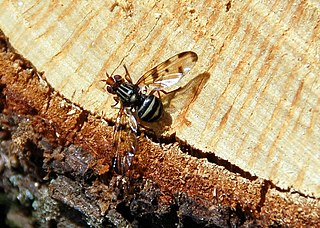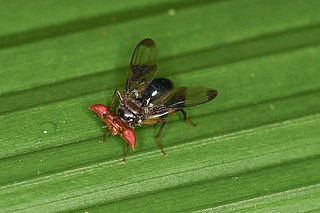
The Ulidiidae or picture-winged flies are a large and diverse cosmopolitan family of flies (Diptera), and as in related families, most species are herbivorous or detritivorous. They are often known as picture-winged flies, along with members of other families in the superfamily Tephritoidea that have patterns of bands or spots on the wings. Some species share with the Tephritidae an unusual elongated posteroapical projection of the anal cell in the wing, but can be differentiated by the smoothly curving subcostal vein. Two species, Tetanops myopaeformis and Euxesta stigmatias, are agricultural pests.

The Lauxaniidae are a family of acalyptrate flies. They generally are small flies with large compound eyes that often are brightly coloured in life, sometimes with characteristic horizontal stripes, such as in Cestrotus species. Many species have variegated patterns on their wings, but in contrast they generally do not have variegated bodies, except for genera such as Cestrotus, whose camouflage mimics lichens or the texture of granitic rocks.

Tomoplagia is a genus of tephritid or fruit flies in the family Tephritidae.

Otites is a genus of picture-winged fly in the family Ulidiidae.

Goniini is a tribe of parasitic flies in the family Tachinidae. Members of Goniini are distinguished from other Tachinidae by laying small "microtype" eggs that hatch only after being ingested by a host.

Otitinae is the name of a subfamily of flies in the family Ulidiidae. It was formerly the Otitidae. Like the Ulidiinae, most species are herbivorous or saprophagous. Most species share with the Tephritidae an unusual elongated projection of the anal cell in the wing, but can be differentiated by the smoothly curving subcostal vein. Most are dull gray to shiny brown or black flies with vein R1 setulose or, in a few cases, bare.

Platystomatinae is a subfamily of flies (Diptera) in the family Platystomatidae that includes 80 genera, the largest subfamily with at last estimate, c. 900 species globally.

Platystoma is a genus of flies (Diptera) belonging to the family Platystomatidae.

Dioxyna is a genus of fruit flies in the family Tephritidae. There are about 10 described species in Dioxyna.

Richardia is a genus of flies in the family Richardiidae. It was first described by French entomologist Jean-Baptiste Robineau-Desvoid in 1830. It occurs from Mexico to Central and South America.

Tetanocera is a genus of marsh flies, insects in the family Sciomyzidae. There are at least 50 described species in Tetanocera.

Myennidini is a tribe of picture-winged flies in the family Ulidiidae.
Odontomera is a genus of flies in the family Richardiidae. There are about 19 described species in Odontomera.

Sciomyzinae is a subfamily of flies in the family Sciomyzidae.

Cephaliini is a tribe of picture-winged flies in the family Ulidiidae.












